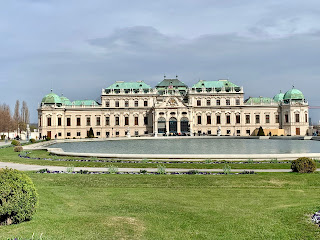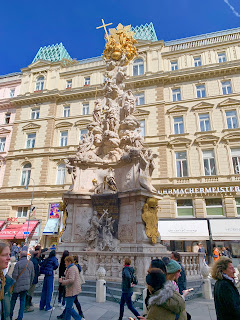29th - 30th Mar 2024
 |
| A rather misty view looking south over Prague from the Castle |
After another detailed 'briefing' session by our 'fuhrer' it was onwards at 9.10am from Vienna to Prague by another comfortable (if slightly delayed) ICE train. We arrived at Prague Central Station (left) at 1.10pm.
Right: Our guide, Radish, I think he was called, (the man in front), who met us on our arrival at the station. We were taken straight off on an introductory walk around the Old Town. Radish, as with our previous guide, was not short for words and with a strong 'Czech' accent. I suspect I missed much of his plentiful and knowledgeable detail.
Left: Václavské Náměsti, or Wenceslas Square as we know it, in the city centre. The National Museum is at the top behind the statue of St.Wenceslas. 'King' or 'Saint' Wenceslaus was a Bohemian Duke assassinated by his brother in the mid 10th century and is the Patron Saint of the Czech Republic. Lots of fables surround his life. I'm sure he was a good chap.
This Square has been a famous venue for various demos and riots; notably during the Prague Spring in 1968 when, after violent demos in favour of repealing many of the restrictive Communist dictats (c/o Alexander Dubčhek), the Soviet tanks rolled in to restore the Commie order. Then, in 1989, the Velvet Revolution (c/o Václav Havel) which resulted in the end of the Communist one-party state and a bit of democratic freedom.
It was Easter weekend and the Czechs take Easter quite seriously. Elaborately decorated eggs form a big part of this signifying 'the start of life'. Right: A stall displaying lots of decorated eggs.
Another quaint Czech Easter tradition is the 'Easter whip', when young girls are splashed with water and 'lightly' whipped with willow branches as a symbol of health and fertility. Rather fun I would have thought. Perhaps it will catch on here?
Left: The old Town Hall. It has a weird 'astronomical clock' on the wall of the tower. It is the source of considerable interest to tourists.
Right: The elaborate clock. I could not make head nor tail of how it told the time. There were several interacting dials with sun and moon symbols and various little articulated statuettes surrounding it. I think something came out of the door on the left on occasions. On the hour (when I was present) there was a little skeleton statuette (top right of clock) which rang a bell and then the clock chimed many times. I was none the wiser.
Left: There were massive crowds around the square in front to watch the clock 'perform'. Indeed, over this Easter weekend the city, especially the Old Town area, was packed with tourists.
Right: The Old Town Square with the twin towers of the Church of our Lady in the background.
Left: A rather elegant form of tourist transport. Is it a Škoda? I have a Škoda (Fabia). A fine car. They originated in Czechoslovakia.
Right: ......as well as the ubiquitous 'horses and cabbages'. (see Vienna).
Left: The very jolly market in the Old Town Square.
Below: There was also a very jolly band, plus singer, performing here.
The main streets leading north to the wide River Vltava (Moldau in German) were full of very upmarket and expensive shops (Prada, Louis Vuitton, Gucci etc.) and even one, I suspect Jewish owned, called Yves Salomon. Just before one of the bridges is this building (right). It was the Nazi SS HQ during WW2. It is now the Office for Trade or similar.
Back to our hotel in the north of the city, called the Vienna House by Wyndham Diplomat Prague (for short). It was very comfortable; much more so than I am used to and close to a Metro underground station. Interestingly and conveniently, use of all public transport, Metro, trams and buses, for those 'over a certain age', is totally free! I doubt that idea will catch on in UK. The Metro system is very efficient and simple to use.
That evening we had another 'communal' supper in the hotel. I'm afraid that I found what conversation I managed with my fellow 'tourers' somewhat limited and boring. We didn't seem to have much of interest in common. I'm sure they found me equally tedious. Hey Ho, but these meals are included in the price of the trip!
The next morning we set off on a conducted tour of Prague Castle on a hill to the north of the river (left). Apparently this castle complex is the largest ancient castle (complex) in the world and contains several compounds including the residence and workplace of the President amongst other 'grand' official buildings. The Bohemian Crown Jewels are kept hidden away somewhere in here. The original build was in the 9th century and became the seat of power for kings of Bohemia.
I'm afraid I got a bit muddled by our guide Radish's comprehensive commentary so not quite sure which bit was what. Right: The entrance.
Left: The forecourt inside the entrance.
Right: Another entrance to something or other.
Left: There were military guards, armed to the teeth, at various points. They were taking no chances with dangerous tour groups such as our bunch of vicious geriatric militants!
Right: I believe this building is used for State Visits and entertaining and accommodating important guests (not us) who come for conferences etc.
Left: There were two smart guards outside. Having said that I couldn't help but notice that their trousers needed ironing and their boots a bit more polish.
Right: I think this is the Presidential Residence.
Left: The tallest and most impressive building is the Saint Vitus Cathedral (he of St Vitus Dance fame). The original version was built in 930 AD, but enlarged and modified over successive centuries. There was a long queue to get inside.
As with so many of these old religious buildings it is very ornate and expensively decorated. It still holds services and has a vast organ plus several impressive stained glass windows There are several 'tombs' inside, of whom I can't remember (Kings and Saints). I think the bones of Saint/King Wenceslas are in here somewhere.
Right: This amazing construction covers the tomb of someone or other. It is made of solid silver. No expense spared!
Left: Looking down part of the length of the nave.
We were shown around several other buildings including a vast banqueting and reception area into which, originally, diners and guests could bring in their horses. Haynets 'a la carte' no doubt.
There is also a small room high up in one building which was famous for 'defenestrations'. These occurred on several occasions, notably in 1618, and usually involved Protestants pushing Catholics out of the window to their death. Or it might have been the other way round. They were the cause of much conflict. Look up 'Defenestration of Prague' if you are interested.
There is a line of 'original' shops and eateries built into one of the outside castle walls. Right: This is an example of a medieval McDonalds. It looks similar to my old army Mess dining-room.
Following the castle tour I walked down to the river and, specifically, to the famous 14th century Charles Bridge (Karlův Most). It was the only crossing of the River Vltava from the castle to the city until 1841. There are now several bridges.
Left: It was packed with tourists and very slow going to get across.
There were stalls along the sides selling jewellery and souvenirs and, curiously, several doing caricature portraits (and good ordinary ones) of willing sitters. Baroque statues such as these (right) stood on the side walls.
Left: There was at least one band playing.
Right: A view north-east up the river. Tour boats are popular.
Back in the Old Town we were taken by our 'leader' on a short tour of the 'Jewish' sector of the city, or at least what was the Jewish sector. It featured several somewhat uninspiring synagogues (some still in use) and stories about how the Jews were segregated and treated rather badly.
Left: This statue, outside a synagogue, is of Franz Kafka, a famous German speaking Prague Bohemian/Jewish writer of very surreal and bizarre stories. The expression 'Kafkaesque' implies 'odd and nightmarish'. He died in 1924.
 I paid a visit to the Museum of Communism. It seems that all these once 'Soviet' dominated countries make a big play of demonstrating, in museums, their transformation from restrictive and sometimes brutal communism to the present day capitalist democracy. Right: It was on two floors and showed the transformation from the Prague Spring in 1968 to 'liberation' in 1989 with all the stories concerning those involved (from Alexander Dubček era to Václav Havel).
I paid a visit to the Museum of Communism. It seems that all these once 'Soviet' dominated countries make a big play of demonstrating, in museums, their transformation from restrictive and sometimes brutal communism to the present day capitalist democracy. Right: It was on two floors and showed the transformation from the Prague Spring in 1968 to 'liberation' in 1989 with all the stories concerning those involved (from Alexander Dubček era to Václav Havel). Left: There is a photo displayed here of the participants in the somewhat disastrous Munich Agreement in 1938, which allowed Germany to annex part of Czechoslovakia known as the Sudetenland.
Left: There is a photo displayed here of the participants in the somewhat disastrous Munich Agreement in 1938, which allowed Germany to annex part of Czechoslovakia known as the Sudetenland. Lt to Rt: Chamberlain (UK), Daladier (France), Hitler (Germany), Mussolini and Caino (Italy). It seems the Czechs were not consulted.
Right: I spent an interesting hour or two in the Slivovitz Museum (near the western end of the Charles Bridge). It was a very 'high-tech' and impressive demo of how the plum based and powerful spirit Slivovitz was founded (in Czechoslovakia) and made. In one of the rooms (and I was the only visitor at the time) I was given 'virtual reality' goggles to experience the life of a plum from tree, via processing, to being bottled and labelled. It was rather disorientating!
On getting back to the reception area I was treated to three 'shots' of Slivovitz with accompanying savoury snacks. One was 'normal' Slivovitz, one honey flavoured and one made in Chile. Delicious!
Again, as in Vienna (and Poland and Portugal) there were several shops selling cannabis in various forms. I was/am not tempted to try it. I might like it and I have enough vices already, thank you.
My travels would not be complete without finding and sampling an 'Oirish Bear'. There were probably several but this one, Caffrey's (left) somewhere in the Old Town, was a most hospitable place.
I also called in at a prestigious Czech beer establishment called 'Pilsner Urquell' (right) which is part beer museum and part bar. I had hoped to meet a friend of a friend who works here, but he was away that day. I did spend a bit of time in the bar. The beer in this city is, compared to most other countries, cheap. The equivalent of a pint can be less than £3.00. That is about half the price of a pint in UK ( or one third of the price in London!). Apparently Prague is getting a bit of a reputation for 'lad's drunken holidays' as a result. No doubt the Brits are heavily involved.
I'm sure I have missed out on other sights and places of interest, but that will do from Prague. It really is a most attractive and pleasant city, or at least the bits I saw were.
Tomorrow ( 31st, Easter Sunday, and I must remember to put my clocks forward) we are off to Berlin..........Stand-by for more from there. Achtung!











































































